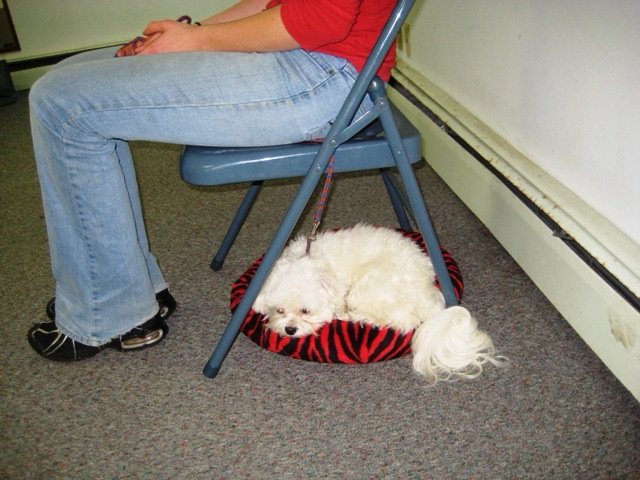Dogs don’t come pre-programmed for calm. It’s a learned behavior, especially in stimulating environments. For dogs to learn to self-control, we have to show them how. That’s the purpose of this exercise called “Sit on the Dog.”
You won’t be sitting on your dog, but on their leash. You won’t be telling your dog what to do, you’ll allow them to choose to be calm. With enough practice in a wide variety of environments, dogs can learn to “settle” almost anywhere.
You’ll need a hard, non-upholstered chair like a dining, patio or folding chair. Avoid armchairs, sofas, rolling chairs, and swivel chairs whenever possible.
Attach the leash to your dog’s harness.
Lay the leash across the chair seat (or hold it against the back of your thighs).
Sit on the leash.
Hold the handle on one side of your legs.
The remaining leash should be free between your leg and your dog. Modify how much leash your dog has based on how close their trigger is. Ditto for sharp furniture corners, glass, etc. You want them to have as much as possible, but safety comes first.
Ignore your dog completely.
No talking, no commands, no eye contact, no petting, no playing. You’re free to read, be online, watch TV, etc.
Your job is to remain still and quiet and disengaged from your dog.
Talking will excite your dog.
Movement will excite your dog.
Play will excite your dog.
Commands will excite your dog.
Eye contact will excite your dog.
You can provide a mat or bed next to or under your chair for your dog to lie on if desired. It’s the dog’s choice where they settle.
You can provide your dog with a chew during this exercise. Place the chew on the floor next to your chair when you sit down. Don’t hand it to your dog. Don’t engage with them otherwise, please.
For best results, practice this behavior daily when you don’t need it, while your dog is calm.

Like all dog behavior exercises, begin with short durations and build on that. Start counting when your dog calms down. Begin with 1 minute.
Add a minute or 2 at a time during each practice until your dog can settle for 5 minutes. After that you can add 5 – 10 minutes each practice.
When you’re finished, stand up, remove the leash and walk away.
Don’t congratulate your dog, pet them or otherwise excite them to avoid distracting them from the lesson: calm self-control.
Dee Green has been a professional dog trainer and canine behavior consultant for more than 20 years. She specializes in puppies up to 18 months, and fearful, anxious and reactive dogs of all ages.
©️2024 Dee Green
